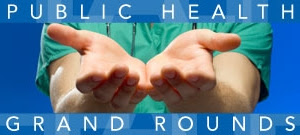
We are pleased to announce the next session of Public Health Grand Rounds, titled “Public Health Strategies to Prevent Preterm Birth,” which will be held on Monday, November 16, 2015, at an earlier time, 10 a.m. (ET).
During the final months of pregnancy, a growing baby goes through important stages of development. The earlier a baby is born, the higher the risk of death or serious disability. Preterm birth, the birth of an infant before 37 weeks of pregnancy, is the largest contributor to infant death. Infants born before 32 weeks gestation bear the biggest burden – representing more than 50 percent of infant deaths. Premature births also pose a long-lasting financial burden on the individual, their families and society. In 2005, the Institute of Medicine reported that each year the cost associated with premature birth in the United States was over $26 billion.
Since 1990, the nation’s overall infant mortality rate has declined nearly 35 percent and the rate of preterm births decreased to 11.3 percent in 2013. However, these national declines have not erased racial disparities within the US. Preterm-related causes of death are more than three times higher for black infants than for white infants. Disparities are also seen for Native American infants.
Preterm birth is complex and remains a challenge because its causes are numerous, and poorly understood. Modern technology and stronger public health strategies have made a significant impact in reducing preterm births and infant mortality. However, we still have a lot to learn about the causes of premature birth in order to prevent it and protect the youngest members of our society, especially among racial and ethnic minorities.
Please join us for this session of Grand Rounds as we discuss how concerted efforts to improve surveillance data, better medical care and prevention, and stronger public health partnerships, can accelerate progress in reducing preterm births and improving neonatal outcomes.
Future Grand Rounds topics include “Developing a Culture of Laboratory Safety” and “The Role of Modeling in Emergency Response.”
Email your questions about this topic before or during the session. Follow us on Twitter #cdcgrandrounds
CDC’s Public Health Grand Rounds Presents:
“Public Health Strategies to Prevent Preterm Birth”
Monday, November 16, 2015
10:00 a.m. – 11:00 a.m., ET
Global Communications Center (Building 19)
Alexander D. Langmuir Auditorium
Roybal Campus
Please note that this session will be presented on a special date and at an earlier time to coincide with the 2015 Prematurity Prevention Conference. We will return to our regular schedule next month.
Presented By:
Wanda Barfield, MD, MPH
Director, Division of Reproductive Health
National Center for Chronic Disease Prevention and Health Promotion, CDC
“Preterm Birth in the United States: Where We Stand”
Arthur James, MD Associate Clinical Professor, Department of Obstetrics and Gynecology
Ohio State University Wexner Medical Center
“Tackling the U.S. Black and White Racial Disparity in Infant Mortality”
Zsakeba Henderson, MD Medical Officer, Division of Reproductive Health
National Center for Chronic Disease Prevention and Health Promotion, CDC
“Preventing Preterm Birth One State at a Time: Perinatal Quality Improvement Collaboratives”
Jennifer L. Howse, PhD
President March of Dimes Foundation
“The 2030 Goal: Public-Private Partnerships to Prevent Preterm Birth”
Facilitated By:
John Iskander, MD, MPH, Scientific Director, Public Health Grand Rounds
Phoebe Thorpe, MD, MPH, Deputy Scientific Director, Public Health Grand Rounds
Susan Laird, MSN, RN, Communications Director, Public Health Grand Rounds
For CDC staff unable to attend the event:
The session will be available on IPTV and Envision. To join by Envision, reserve a conference room and make the Envision request or use your local room scheduling process to schedule Envision.
For non-CDC staff interested in viewing the session:
A live external webcast will be available. For individuals who are unable to view the session during the scheduled time, the archived presentation will be posted 48 hours after each session.
For non-CDC staff who wish to attend in person:
Due to security measures at CDC’s Roybal campus, non-CDC staff who wish to attend these sessions in person must have prior clearance and a US state-issued photo ID (e.g., driver’s license, US passport).
Names of non-CDC staff (both domestic and international) should be submitted to the Grand Rounds Team. Please note that all information for international visitors must be submitted at least 10 days in advance.
For individuals requiring reasonable accommodations:
It is the policy of CDC to provide reasonable accommodations (RA) for qualified individuals with disabilities to ensure their full inclusion in CDC-sponsored events. Employees are asked to submit RA requests at least 5 business days prior to the event. Please e-mail the request to grandrounds@cdc.gov.
Grand Rounds is available for Continuing Education.
ALL Continuing Education hours for Public Health Grand Rounds (PHGR) are issued online through the CDC/ATSDR Training and Continuing Education Online system. If you have questions, e-mail or call Learner Support at 1-800-418-7246 (1-800-41TRAIN).
Those who attend PHGR either in person, Envision, IPTV, or “web on demand” and who wish to receive continuing education must complete the online seminar evaluation. Thirty days from the initial seminar the course number will change to WD2346 and will be available for continuing education until February 18, 2016. The course code for PHGR isPHGR10.
Target Audience: Physicians, nurses, epidemiologists, pharmacists, veterinarians, certified health education specialists, laboratorians, others
Objectives:
- List key measures of burden of disease involving morbidity, mortality, and/or cost.
- Describe evidence-based preventive interventions and the status of their implementations.
- Identify one key prevention science research gap.
- Name one key indicator by which progress and meeting prevention goals is measured.
CE certificates can be printed from your computer immediately upon completion of your online evaluation. A cumulative transcript of all CDC/ATSDR CE’s obtained through the TCE Online System will be maintained for each user. We hope that this will assist CDC staff and other public health professionals to fulfill the requirements for their professional licenses and certificates.
Learn more about continuing education on the Grand Rounds website.






















.png)








No hay comentarios:
Publicar un comentario